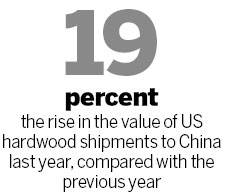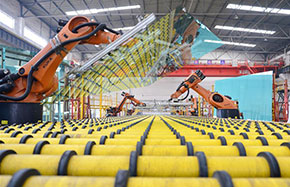US hardwood exporters branch out in Chinese furniture, building sector
Government plans to build 1 billion sq m of 'green' buildings
United States-based hardwood exporters are boosting their growth in China's furniture, decoration and eco-friendly building material markets as the nation pushes to accelerate the pace of its urbanization drive.
Michael Snow, executive director of the American Hardwood Export Council, said that amid the continuing uncertainty in many Western economies, the growth rate of the usage of US hardwood across China and Southeast Asia has been stable over the past few years.
The China and Southeast Asia regional market, covering China, Indonesia, Malaysia, the Philippines, Singapore, Thailand and Vietnam, has become the largest export market for US hardwood producers and accounts for 52 percent, or $1.2 billion, of global exports in 2012, with China alone representing 38 percent of these exports, according to the foreign agricultural service of the US Department of Agriculture.
The US is the world's largest producer and exporter of hardwood lumber, representing 20 percent of global shipments. Last year, US hardwood shipments to China rose 19 percent in terms of value compared with the previous year.
The value of all of the US hardwood exports to China in 2012 - such as lumber, veneer, plywood and flooring products - reached its highest value ever at $602 million.
Headquartered in Washington DC, the American Hardwood Export Council is an international non-profit trade association of the US hardwood industry. It represents over 100 US hardwood exporters and major hardwood product trade associations in the US.
"Even though the future demand of China's furniture market continues to depend on the domestic housing market and the country has implemented a number of policies to stabilize the property prices and prevent housing speculation, China has entered the second phase of urbanization, which will lead to another wave in consuming hardwood and timber products," Snow said.
He added that China's fast urbanization process and rigid housing demand to a certain extent have created a new generation of increasingly affluent consumers who are keen to outfit their homes and offices with quality interior furnishings made with US hardwood.
Rupert Oliver, director of Forest Industries Intelligence Ltd, a UK-based consultancy serving a range of clients in the international forest products sector, said there is a growing need to combine economic growth and environmental concerns. In China, the use of wood products and renewable materials can significantly cut carbon dioxide emissions, he added.

According to China's 12th Five-Year Plan (2011-15), the nation plans to reduce carbon emissions per unit of GDP by 17 percent in 2015.
"This is part of the Chinese government's strategy to eliminate the impact caused by global warming, declining ecosystems and water contamination," Oliver said.
The Chinese government also plans to build 1 billion square meters of "green" buildings between 2011 and 2015, and to ensure that eco-friendly buildings account for 20 percent of all the new urban buildings by 2015.
Another factor that has stimulated China's hardwood imports is the government's protection of the country's wood resources.
China began to protect its forests in 1998 after it was hit by a timber shortage of about 60 million cubic meters per year. The country will be heavily dependent on imported timber resources from the US, Canada, Russia, Germany and Cameroon for the next 30 years.
- US to continue probes into China's hardwood, plywood
- US starts probe on China hardwood, plywood imports
- Furniture makers not yet sitting pretty
- Production decreases in furniture industry
- Profit and production eases in China's furniture industry
- Furniture industry 'in a slump': Report
- Old-for-new furniture plan takes off



















